Corporations & Trusts Law Assignment
Submission instructions for the Corporations & Trusts Law assignment in the Monarch Learning Management System (LMS).
45 Pages10437 Words227 Views
Added on 2023-04-20
About This Document
This assignment covers the application of legal principles in corporations and trust law. It requires the completion of a set of questions in relation to choosing a business structure, the company as a separate legal entity, and more.
Corporations & Trusts Law Assignment
Submission instructions for the Corporations & Trusts Law assignment in the Monarch Learning Management System (LMS).
Added on 2023-04-20
ShareRelated Documents
Corporations & Trusts Law
Assignment
Submission Instructions:
Key steps that must be followed:
1. Please complete the Declaration of Authenticity at the bottom of this page.
2. Once you have completed all parts of the assessment and saved it (eg. to your desktop
computer), log in to the Monarch Learning Management System (LMS) to submit your
assessment.
3. In the LMS, click on the file "Submit Corporations & Trusts Law assignment” in the
Corporations & Trusts Law section of your course and upload your assessment file/s by
following the prompts.
4. Please be sure to click “Continue” after clicking “submit”. This ensures your assessor
receives notification – very important!
Declaration of Understanding and Authenticity*
I have read and understood the assessment instructions provided to me in the Learning Management System.
I certify that the attached material is my original work. No other person’s work has been used without due
acknowledgement. I understand that the work submitted may be reproduced and/or communicated for the purpose
of detecting plagiarism.
Student Name*: Date:
* I understand that by typing my name or inserting a digital signature into this box that I agree and am bound by the
above student declaration.
Assignment
Submission Instructions:
Key steps that must be followed:
1. Please complete the Declaration of Authenticity at the bottom of this page.
2. Once you have completed all parts of the assessment and saved it (eg. to your desktop
computer), log in to the Monarch Learning Management System (LMS) to submit your
assessment.
3. In the LMS, click on the file "Submit Corporations & Trusts Law assignment” in the
Corporations & Trusts Law section of your course and upload your assessment file/s by
following the prompts.
4. Please be sure to click “Continue” after clicking “submit”. This ensures your assessor
receives notification – very important!
Declaration of Understanding and Authenticity*
I have read and understood the assessment instructions provided to me in the Learning Management System.
I certify that the attached material is my original work. No other person’s work has been used without due
acknowledgement. I understand that the work submitted may be reproduced and/or communicated for the purpose
of detecting plagiarism.
Student Name*: Date:
* I understand that by typing my name or inserting a digital signature into this box that I agree and am bound by the
above student declaration.

Important assessment information
Aims of this assessment
This assessment covers the application of legal principles in corporations and trust law.
It requires the completion of a set of questions in relation to:- choosing a business structure; the
company as a separate legal entity, including management, directors duties and the external
administration of a company.
Share capital and fundraising, along with associations and trusts are covered with practice-based
scenarios. The assessment task includes client specific scenarios on a partnership agreement;
changing a business structure; a company takeover; and a business which encounters financial
difficulties.
The significance of case law is explored and a brief ASIC case study is also provided. The relevance
of several sections of the Corporations Act is also explored.
The advantages and disadvantages of incorporated and unincorporated associations which are
common in the community and not-for-profit sector are also analysed.
The framework of the Australian legal system is not assessed in this unit of competency as it is
assessed in unit FNSTPB505 Property Law.
Preparing your responses
Please refer to the beginning of the text and familiarise yourself with the sections on 'Case
Studies, Scenarios and Problem Questions', and 'How to answer a question'. This will assist you to
formulate your response.
Marking and feedback
This assignment contains 10 assessment activities based upon ten chapters of the textbook. Each
assessment activity contains specific instructions.
Chapter 1 is not assessed in this unit.
This particular assessment forms part of your overall assessment for the following unit of
competency:
FNSTPB504 Apply legal principles in corporations and trust law (MCL002)
Grading for this assessment will be deemed “competent” or “not-yet-competent” in line with
specified educational standards under the Australian Qualifications Framework.
What does “competent” mean?
Aims of this assessment
This assessment covers the application of legal principles in corporations and trust law.
It requires the completion of a set of questions in relation to:- choosing a business structure; the
company as a separate legal entity, including management, directors duties and the external
administration of a company.
Share capital and fundraising, along with associations and trusts are covered with practice-based
scenarios. The assessment task includes client specific scenarios on a partnership agreement;
changing a business structure; a company takeover; and a business which encounters financial
difficulties.
The significance of case law is explored and a brief ASIC case study is also provided. The relevance
of several sections of the Corporations Act is also explored.
The advantages and disadvantages of incorporated and unincorporated associations which are
common in the community and not-for-profit sector are also analysed.
The framework of the Australian legal system is not assessed in this unit of competency as it is
assessed in unit FNSTPB505 Property Law.
Preparing your responses
Please refer to the beginning of the text and familiarise yourself with the sections on 'Case
Studies, Scenarios and Problem Questions', and 'How to answer a question'. This will assist you to
formulate your response.
Marking and feedback
This assignment contains 10 assessment activities based upon ten chapters of the textbook. Each
assessment activity contains specific instructions.
Chapter 1 is not assessed in this unit.
This particular assessment forms part of your overall assessment for the following unit of
competency:
FNSTPB504 Apply legal principles in corporations and trust law (MCL002)
Grading for this assessment will be deemed “competent” or “not-yet-competent” in line with
specified educational standards under the Australian Qualifications Framework.
What does “competent” mean?
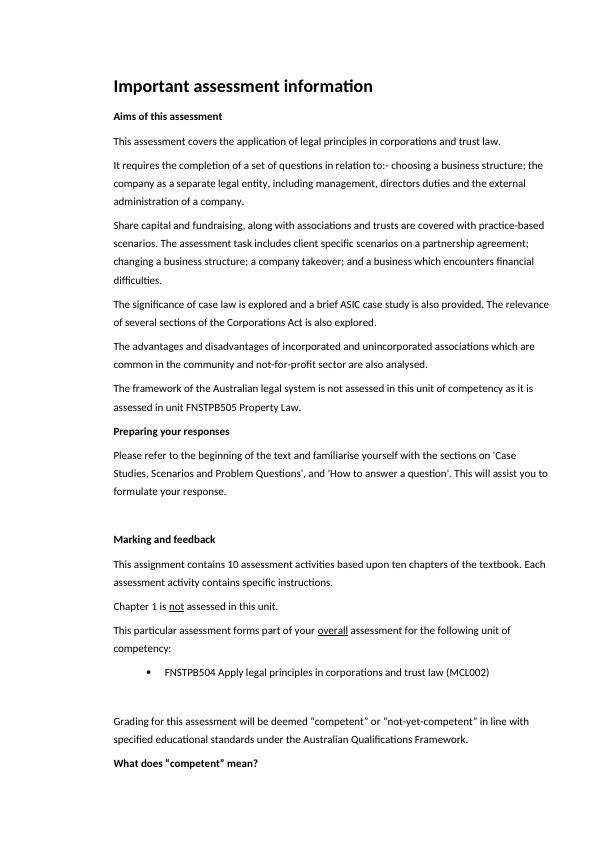
These answers contain relevant and accurate information in response to the question/s with
limited serious errors in fact or application. If incorrect information is contained in an answer, it
must be fundamentally outweighed by the accurate information provided. This will be assessed
against a marking guide provided to assessors for their determination.
What does “not-yet-competent” mean?
This occurs when an assessment does not meet the marking guide standards provided to
assessors. These answers either do not address the question specifically, or are wrong from a
legislative perspective, or are incorrectly applied. Answers that omit to provide a response to any
significant issue (where multiple issues must be addressed in a question) may also be deemed
not-yet-competent. Answers that have faulty reasoning, a poor standard of expression or include
plagiarism may also be deemed not-yet-competent. Please note, additional information regarding
Monarch’s plagiarism policy is contained in the Student Information Guide which can be found
here: http://www.monarch.edu.au/student-info/
What happens if you are deemed not-yet-competent?
In the event you do not achieve competency by your assessor on this assessment, you will be
given one more opportunity to re-submit the assessment after consultation with your Trainer/
Assessor. You will know your assessment is deemed ‘not-yet-competent’ if your grade book in the
Monarch LMS says “NYC” after you have received an email from your assessor advising your
assessment has been graded.
Important: It is your responsibility to ensure your assessment resubmission addresses all areas
deemed unsatisfactory by your assessor. Please note, if you are still unsuccessful in meeting
competency after resubmitting your assessment, you will be required to repeat those units.
In the event that you have concerns about the assessment decision then you can refer to our
Complaints & Appeals process also contained within the Student Information Guide.
Expectations from your assessor when answering different types of assessment questions
Knowledge-based questions:
A knowledge-based question requires you to clearly identify and cover the key subject matter
areas raised in the question in full as part of the response.
Good luck
Finally, good luck with your learning and assessments and remember your trainers are here to
assist you
Assessment Activity 1:
Negligence and Risk ( Chapter 2)
limited serious errors in fact or application. If incorrect information is contained in an answer, it
must be fundamentally outweighed by the accurate information provided. This will be assessed
against a marking guide provided to assessors for their determination.
What does “not-yet-competent” mean?
This occurs when an assessment does not meet the marking guide standards provided to
assessors. These answers either do not address the question specifically, or are wrong from a
legislative perspective, or are incorrectly applied. Answers that omit to provide a response to any
significant issue (where multiple issues must be addressed in a question) may also be deemed
not-yet-competent. Answers that have faulty reasoning, a poor standard of expression or include
plagiarism may also be deemed not-yet-competent. Please note, additional information regarding
Monarch’s plagiarism policy is contained in the Student Information Guide which can be found
here: http://www.monarch.edu.au/student-info/
What happens if you are deemed not-yet-competent?
In the event you do not achieve competency by your assessor on this assessment, you will be
given one more opportunity to re-submit the assessment after consultation with your Trainer/
Assessor. You will know your assessment is deemed ‘not-yet-competent’ if your grade book in the
Monarch LMS says “NYC” after you have received an email from your assessor advising your
assessment has been graded.
Important: It is your responsibility to ensure your assessment resubmission addresses all areas
deemed unsatisfactory by your assessor. Please note, if you are still unsuccessful in meeting
competency after resubmitting your assessment, you will be required to repeat those units.
In the event that you have concerns about the assessment decision then you can refer to our
Complaints & Appeals process also contained within the Student Information Guide.
Expectations from your assessor when answering different types of assessment questions
Knowledge-based questions:
A knowledge-based question requires you to clearly identify and cover the key subject matter
areas raised in the question in full as part of the response.
Good luck
Finally, good luck with your learning and assessments and remember your trainers are here to
assist you
Assessment Activity 1:
Negligence and Risk ( Chapter 2)
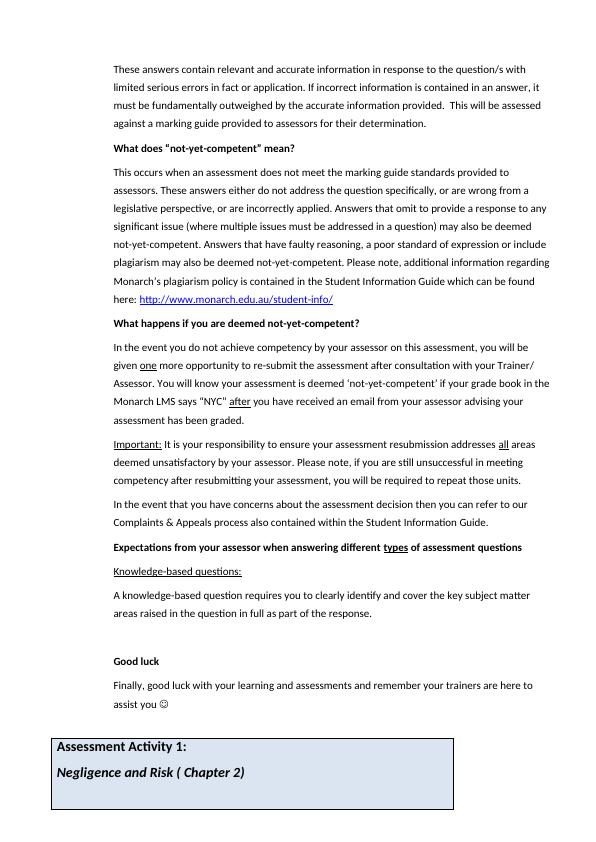
Activity instructions to candidates
This is an open book assessment activity.
You are required to read this assessment and answer all 4 questions that follow.
Please type your answers in the spaces provided.
Please ensure you have read “Important assessment information” at the front of this assessment
Estimated time for completion of this assessment activity: 2 hours
Question 1.1
Explain the elements necessary for negligence to be established.
Negligence is an act done by a person without applying any skill with a careless and reckless
attitude which causes damages to the person (Ryan, Callaghan and Large 2015).
The following are the basic elements of negligence:
1. Duty: The basic outcome of the act depends upon the duty of the plaintiff to the defendant. The
act shall be done on the basis of the requirement set by the plaintiff.
2. Breach of Duty: The breach of duty occurs when the defendant fails to perform the specific task
or fails to meet the requirements of the plaintiff.
3. Cause in Fact: The plaintiff of the act has to prove in the court of law that the defendant was
unable to perform his/her duty which has caused injury to them.
4. Proximate Cause: It is a cause which provides information regarding the responsibility of the
defendant to perform a specific act which has been performed in a negligent manner and such
negligence has caused injury to the plaintiff.
5. Damages: The plaintiff of the case has to explain and prove in the court of law regarding the
damages and injury caused in the form of physical injury or damage to property from the
negligent actions of the defendant (Barry, 2017).
This is an open book assessment activity.
You are required to read this assessment and answer all 4 questions that follow.
Please type your answers in the spaces provided.
Please ensure you have read “Important assessment information” at the front of this assessment
Estimated time for completion of this assessment activity: 2 hours
Question 1.1
Explain the elements necessary for negligence to be established.
Negligence is an act done by a person without applying any skill with a careless and reckless
attitude which causes damages to the person (Ryan, Callaghan and Large 2015).
The following are the basic elements of negligence:
1. Duty: The basic outcome of the act depends upon the duty of the plaintiff to the defendant. The
act shall be done on the basis of the requirement set by the plaintiff.
2. Breach of Duty: The breach of duty occurs when the defendant fails to perform the specific task
or fails to meet the requirements of the plaintiff.
3. Cause in Fact: The plaintiff of the act has to prove in the court of law that the defendant was
unable to perform his/her duty which has caused injury to them.
4. Proximate Cause: It is a cause which provides information regarding the responsibility of the
defendant to perform a specific act which has been performed in a negligent manner and such
negligence has caused injury to the plaintiff.
5. Damages: The plaintiff of the case has to explain and prove in the court of law regarding the
damages and injury caused in the form of physical injury or damage to property from the
negligent actions of the defendant (Barry, 2017).
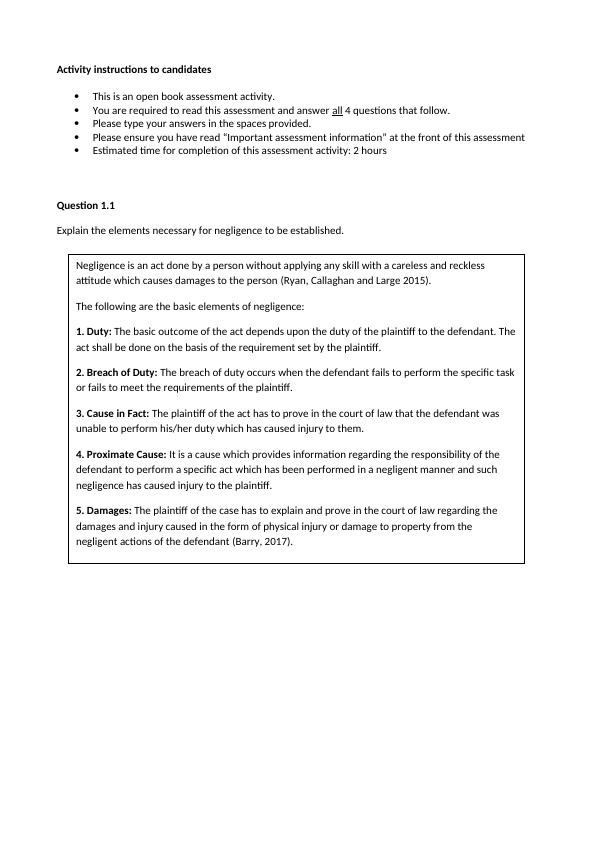
Question 1.2
Jayne is an accountant and business adviser. Christopher and Fleur run a highly
profitable business and sought advice from Jayne as to the best business structure
and practices to legally minimise their rising tax obligations. Jayne did so and
advised Christopher and Fleur to set up a particular kind of trust.
Two years later, following a change in government, the tax laws concerning trusts
were changed significantly. Christopher and Fleur are now obligated to pay 25%
more tax than they would have been under a company structure. They are angry
and believe Jayne has acted negligently. If they were to sue Jayne for negligence,
would they be successful? Why or why not?
Question 1.3
What risk management practices should a tax practitioner/adviser or accountant
adopt to minimise the likelihood of negligence occurring?
As per the above case scenario, it can be observed that Jane has given correct advice to
Christopher and Fleur as per the latest scenario of the date. Christopher and Fleur would not be
successful for using Jane as Jane is not responsible for the changes in policies and plans in the tax
structure of trusts made by the new government. If they sue Jane, then they would not be
successful for negligence as the liability of Jane was excluded when the new government
changed the policies.
The following are the risk management practices which a tax practitioner/ advisor/ accountant
will adapt to minimise the likelihood of negligence:
1. By avoiding risky clients and troublemakers to the organisation.
2. By ensuring the needs and requirements of the clients.
3. By ensuring a professional environment in the workplace.
4. By avoiding delegation of responsibilities to other personnel.
5. By having proper quality control policies and procedures in the organisation.
Jayne is an accountant and business adviser. Christopher and Fleur run a highly
profitable business and sought advice from Jayne as to the best business structure
and practices to legally minimise their rising tax obligations. Jayne did so and
advised Christopher and Fleur to set up a particular kind of trust.
Two years later, following a change in government, the tax laws concerning trusts
were changed significantly. Christopher and Fleur are now obligated to pay 25%
more tax than they would have been under a company structure. They are angry
and believe Jayne has acted negligently. If they were to sue Jayne for negligence,
would they be successful? Why or why not?
Question 1.3
What risk management practices should a tax practitioner/adviser or accountant
adopt to minimise the likelihood of negligence occurring?
As per the above case scenario, it can be observed that Jane has given correct advice to
Christopher and Fleur as per the latest scenario of the date. Christopher and Fleur would not be
successful for using Jane as Jane is not responsible for the changes in policies and plans in the tax
structure of trusts made by the new government. If they sue Jane, then they would not be
successful for negligence as the liability of Jane was excluded when the new government
changed the policies.
The following are the risk management practices which a tax practitioner/ advisor/ accountant
will adapt to minimise the likelihood of negligence:
1. By avoiding risky clients and troublemakers to the organisation.
2. By ensuring the needs and requirements of the clients.
3. By ensuring a professional environment in the workplace.
4. By avoiding delegation of responsibilities to other personnel.
5. By having proper quality control policies and procedures in the organisation.
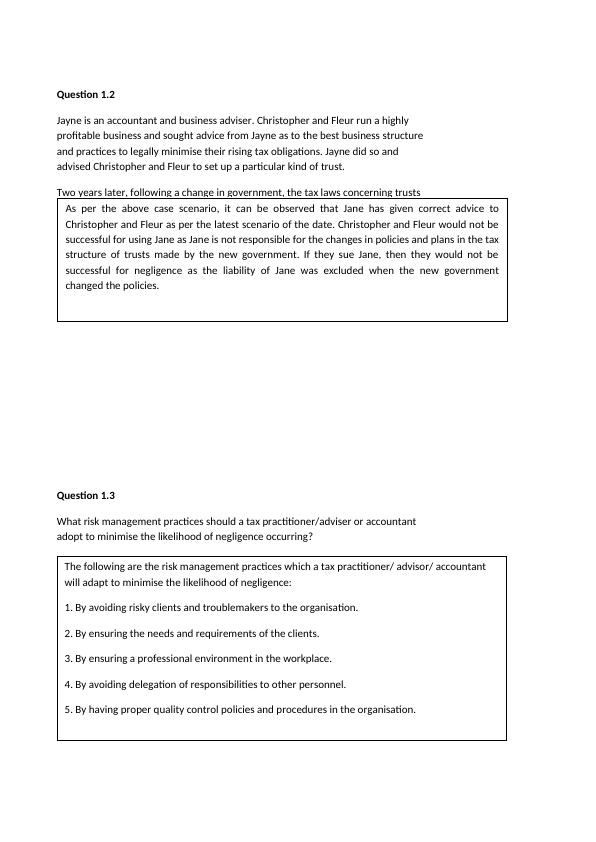
Question 1.4
Give an example of pure economic loss, stating the name of a relevant case.
A pure economic loss is a loss which has been arising from the negligence done by the defendant
to the plaintiff. Such negligence provides injury to the plaintiff in the form of physical injury or
injury to the property of the plaintiff. As per the case law of Hedley Byrne & Co Ltd v Heller and
Partners Ltd (1963) AC 465, it can be observed that Heller and Partners gave wrong information
regarding the financial position and creditworthiness Easipower limited, as a result, Hedley Byrne
suffered $17,000 loss which was a purely economic loss for her.
Give an example of pure economic loss, stating the name of a relevant case.
A pure economic loss is a loss which has been arising from the negligence done by the defendant
to the plaintiff. Such negligence provides injury to the plaintiff in the form of physical injury or
injury to the property of the plaintiff. As per the case law of Hedley Byrne & Co Ltd v Heller and
Partners Ltd (1963) AC 465, it can be observed that Heller and Partners gave wrong information
regarding the financial position and creditworthiness Easipower limited, as a result, Hedley Byrne
suffered $17,000 loss which was a purely economic loss for her.

Activity instructions to candidates
This is an open book assessment activity.
You are required to read this assessment and answer all 4 questions that follow.
Please type your answers in the spaces provided.
Please ensure you have read “Important assessment information” at the front of this assessment
Estimated time for completion of this assessment activity: 2 hours
Question 2.1
What kind of matters should be considered when deciding upon an appropriate business structure?
Assessment Activity 2:
Choosing a business structure ( Chapter 3)
The following are the matters which are to be considered as the most appropriate business
structure:
1. Control over business operations.
2. Understanding liability of the business.
3. Understanding the cost of the legal structure.
4. Understanding the future needs of the organisation.
5. Understanding the tax structure for the organisation.
6. By having an effective administration in the organisation for meeting future goals
(Epstein, 2018).
This is an open book assessment activity.
You are required to read this assessment and answer all 4 questions that follow.
Please type your answers in the spaces provided.
Please ensure you have read “Important assessment information” at the front of this assessment
Estimated time for completion of this assessment activity: 2 hours
Question 2.1
What kind of matters should be considered when deciding upon an appropriate business structure?
Assessment Activity 2:
Choosing a business structure ( Chapter 3)
The following are the matters which are to be considered as the most appropriate business
structure:
1. Control over business operations.
2. Understanding liability of the business.
3. Understanding the cost of the legal structure.
4. Understanding the future needs of the organisation.
5. Understanding the tax structure for the organisation.
6. By having an effective administration in the organisation for meeting future goals
(Epstein, 2018).
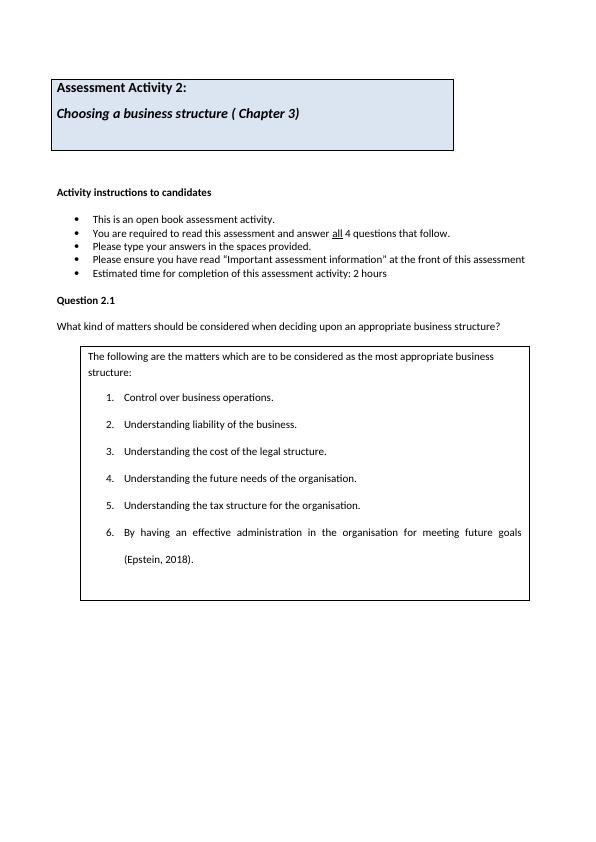
Question 2.2
Steven and Lamont have recently set up an accounting practice in partnership. They have prepared a written
partnership agreement in which it states that any purchase over $1,000 shall only be made after both partners
agree. Steven and Lamont purchased all their office furniture and equipment from Mack at OfficeStuff. Mack
contacted Steven and offered the partnership a great deal on a computer package for $2,000. Lamont is out
seeing clients and cannot be contacted. Steven goes ahead and purchases the computer package. When
Lamont is informed he says the purchase is not valid and wants Mack to take the computer package back and
refund their money. Mack refuses. Discuss the issues raised and the likely outcome of these circumstances.
As per the above case scenario, it can be noted that Mack was not informed about the partnership
deed between Steven and Lamont. Steven broke the clause mentioned in partnership deed hence
Lamont has the right to sue Steven for the purchase of such equipment over $1,000. As per the
principle of agency the third party that is Mack is not responsible for any such liability and he has the
right to receive full payment (Cohen, 2017).
Steven and Lamont have recently set up an accounting practice in partnership. They have prepared a written
partnership agreement in which it states that any purchase over $1,000 shall only be made after both partners
agree. Steven and Lamont purchased all their office furniture and equipment from Mack at OfficeStuff. Mack
contacted Steven and offered the partnership a great deal on a computer package for $2,000. Lamont is out
seeing clients and cannot be contacted. Steven goes ahead and purchases the computer package. When
Lamont is informed he says the purchase is not valid and wants Mack to take the computer package back and
refund their money. Mack refuses. Discuss the issues raised and the likely outcome of these circumstances.
As per the above case scenario, it can be noted that Mack was not informed about the partnership
deed between Steven and Lamont. Steven broke the clause mentioned in partnership deed hence
Lamont has the right to sue Steven for the purchase of such equipment over $1,000. As per the
principle of agency the third party that is Mack is not responsible for any such liability and he has the
right to receive full payment (Cohen, 2017).
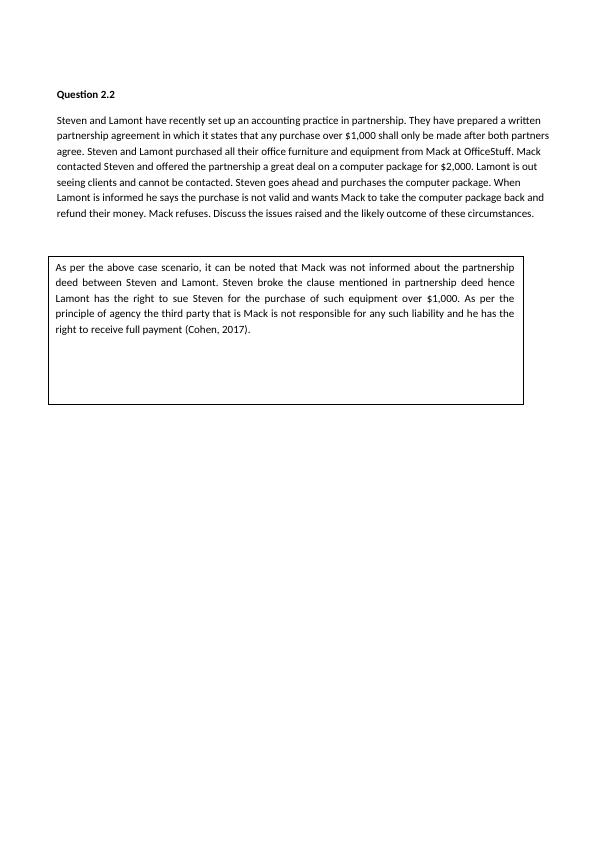
End of preview
Want to access all the pages? Upload your documents or become a member.
Related Documents
Corporations & Trusts Law Assignmentlg...
|37
|7165
|322
Corporations & Trusts Law Projectlg...
|56
|10554
|85
Contract & Consumer Law Assignmentlg...
|29
|8424
|113
Property Law Assignmentlg...
|22
|7723
|172
Property Law Assignmentlg...
|23
|5784
|107
Monarch Learning Management System for SMSF Module 3 Workplace Simulation Submissionlg...
|33
|7261
|310
